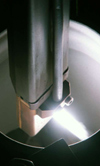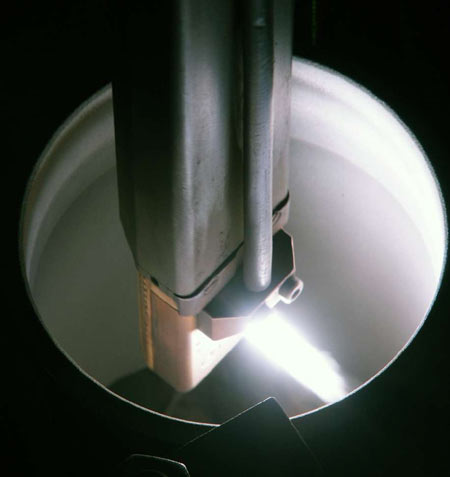Plasma-sprayed coatings
 The use of plasma-sprayed coatings has been slow to proliferate; the technique isn't very new, and the range of coatings is immense. Whereas other coating methods can be limited - by solubility of metal salts in electrolytes, for example - plasma coatings are generally limited only by the availability of material in the correct form and the ability of the coating material to be melted.
The use of plasma-sprayed coatings has been slow to proliferate; the technique isn't very new, and the range of coatings is immense. Whereas other coating methods can be limited - by solubility of metal salts in electrolytes, for example - plasma coatings are generally limited only by the availability of material in the correct form and the ability of the coating material to be melted.
There are a number of sprayed coating methods, distinguished not only by the particular method of coating but also by the ratio and absolute levels of thermal and kinetic energy. The more traditional flame spray processes have low thermal and low kinetic energy, while the HVOF (high velocity oxy-fuel) process has very high kinetic energy but low thermal energy. Owing to the high temperature of the plasma 'plume' generated, plasma spraying has much higher thermal energy than either of these processes, and is approximately intermediate in terms of kinetic energy. The high thermal energy makes plasma spraying particularly suited to spraying materials with high melting points, such as ceramics.
There are two main variants of plasma spray processes: one takes place in ambient atmosphere, the other is carried out in 'vacuum' (or very low pressure) conditions. Obviously, it is much easier to carry out 'atmospheric' plasma spraying, but it has the disadvantage that the coating material has an opportunity to oxidise before it is coated onto the substrate, where it then rapidly cools and is therefore less prone to oxidation. Vacuum or low-pressure plasma spraying is much less prone to oxidation of reactive coating materials, and the coatings are said to be of higher quality.
The plasma flame is formed by passing a gas, which is typically nitrogen (N2), hydrogen (H2) or helium (He) or mixtures of these, between an anode and a cathode. There is a high-frequency arc ignited between the electrodes and the gas which passes between them is thus ionised. The resulting plasma plume can reach temperatures of around 16,000 C (about 29,000 F). The powder material to be coated is fed into the plasma plume or flame, and is almost instantly melted. The high kinetic energy of the plume is sufficient to propel the molten particles at the substrate, where they deform into a flattened 'pancake' form and then solidify.

The process is carried out following a blasting process to roughen the surface and a cleaning process in order to promote adhesion of the coatings. Blasting the surface not only provides increased surface area ratio compared to the nominal 'presented area', but also increases the surface energy of the substrate; both of these effects increase coating adhesion. Suitable substrate materials are those generally with a surface hardness of 55 HRc or lower, which are easy to roughen by blasting, although substrate materials which are harder than 55 HRc can be coated following a special process to roughen the surface.
Fig. 1 - One application of plasma-sprayed coatings in race engines is the coating of cylinder bore surfaces
Written by Wayne Ward